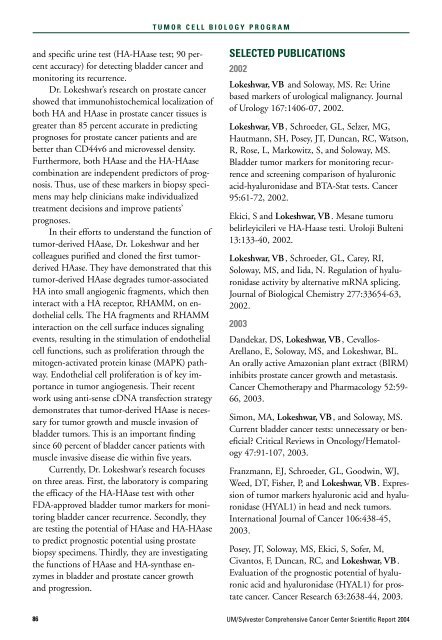SCIENTIFIC REPORT 2004 - Sylvester Comprehensive Cancer Center
SCIENTIFIC REPORT 2004 - Sylvester Comprehensive Cancer Center
SCIENTIFIC REPORT 2004 - Sylvester Comprehensive Cancer Center
You also want an ePaper? Increase the reach of your titles
YUMPU automatically turns print PDFs into web optimized ePapers that Google loves.
T U M O R C E L L B I O L O G Y P R O G R A M<br />
and specific urine test (HA-HAase test; 90 percent<br />
accuracy) for detecting bladder cancer and<br />
monitoring its recurrence.<br />
Dr. Lokeshwar’s research on prostate cancer<br />
showed that immunohistochemical localization of<br />
both HA and HAase in prostate cancer tissues is<br />
greater than 85 percent accurate in predicting<br />
prognoses for prostate cancer patients and are<br />
better than CD44v6 and microvessel density.<br />
Furthermore, both HAase and the HA-HAase<br />
combination are independent predictors of prognosis.<br />
Thus, use of these markers in biopsy specimens<br />
may help clinicians make individualized<br />
treatment decisions and improve patients’<br />
prognoses.<br />
In their efforts to understand the function of<br />
tumor-derived HAase, Dr. Lokeshwar and her<br />
colleagues purified and cloned the first tumorderived<br />
HAase. They have demonstrated that this<br />
tumor-derived HAase degrades tumor-associated<br />
HA into small angiogenic fragments, which then<br />
interact with a HA receptor, RHAMM, on endothelial<br />
cells. The HA fragments and RHAMM<br />
interaction on the cell surface induces signaling<br />
events, resulting in the stimulation of endothelial<br />
cell functions, such as proliferation through the<br />
mitogen-activated protein kinase (MAPK) pathway.<br />
Endothelial cell proliferation is of key importance<br />
in tumor angiogenesis. Their recent<br />
work using anti-sense cDNA transfection strategy<br />
demonstrates that tumor-derived HAase is necessary<br />
for tumor growth and muscle invasion of<br />
bladder tumors. This is an important finding<br />
since 60 percent of bladder cancer patients with<br />
muscle invasive disease die within five years.<br />
Currently, Dr. Lokeshwar’s research focuses<br />
on three areas. First, the laboratory is comparing<br />
the efficacy of the HA-HAase test with other<br />
FDA-approved bladder tumor markers for monitoring<br />
bladder cancer recurrence. Secondly, they<br />
are testing the potential of HAase and HA-HAase<br />
to predict prognostic potential using prostate<br />
biopsy specimens. Thirdly, they are investigating<br />
the functions of HAase and HA-synthase enzymes<br />
in bladder and prostate cancer growth<br />
and progression.<br />
SELECTED PUBLICATIONS<br />
2002<br />
Lokeshwar, VB and Soloway, MS. Re: Urine<br />
based markers of urological malignancy. Journal<br />
of Urology 167:1406-07, 2002.<br />
Lokeshwar, VB , Schroeder, GL, Selzer, MG,<br />
Hautmann, SH, Posey, JT, Duncan, RC, Watson,<br />
R, Rose, L, Markowitz, S, and Soloway, MS.<br />
Bladder tumor markers for monitoring recurrence<br />
and screening comparison of hyaluronic<br />
acid-hyaluronidase and BTA-Stat tests. <strong>Cancer</strong><br />
95:61-72, 2002.<br />
Ekici, S and Lokeshwar, VB . Mesane tumoru<br />
belirleyicileri ve HA-Haase testi. Uroloji Bulteni<br />
13:133-40, 2002.<br />
Lokeshwar, VB , Schroeder, GL, Carey, RI,<br />
Soloway, MS, and Iida, N. Regulation of hyaluronidase<br />
activity by alternative mRNA splicing.<br />
Journal of Biological Chemistry 277:33654-63,<br />
2002.<br />
2003<br />
Dandekar, DS, Lokeshwar, VB , Cevallos-<br />
Arellano, E, Soloway, MS, and Lokeshwar, BL.<br />
An orally active Amazonian plant extract (BIRM)<br />
inhibits prostate cancer growth and metastasis.<br />
<strong>Cancer</strong> Chemotherapy and Pharmacology 52:59-<br />
66, 2003.<br />
Simon, MA, Lokeshwar, VB , and Soloway, MS.<br />
Current bladder cancer tests: unnecessary or beneficial?<br />
Critical Reviews in Oncology/Hematology<br />
47:91-107, 2003.<br />
Franzmann, EJ, Schroeder, GL, Goodwin, WJ,<br />
Weed, DT, Fisher, P, and Lokeshwar, VB . Expression<br />
of tumor markers hyaluronic acid and hyaluronidase<br />
(HYAL1) in head and neck tumors.<br />
International Journal of <strong>Cancer</strong> 106:438-45,<br />
2003.<br />
Posey, JT, Soloway, MS, Ekici, S, Sofer, M,<br />
Civantos, F, Duncan, RC, and Lokeshwar, VB .<br />
Evaluation of the prognostic potential of hyaluronic<br />
acid and hyaluronidase (HYAL1) for prostate<br />
cancer. <strong>Cancer</strong> Research 63:2638-44, 2003.<br />
86<br />
UM/<strong>Sylvester</strong> <strong>Comprehensive</strong> <strong>Cancer</strong> <strong>Center</strong> Scientific Report <strong>2004</strong>
















